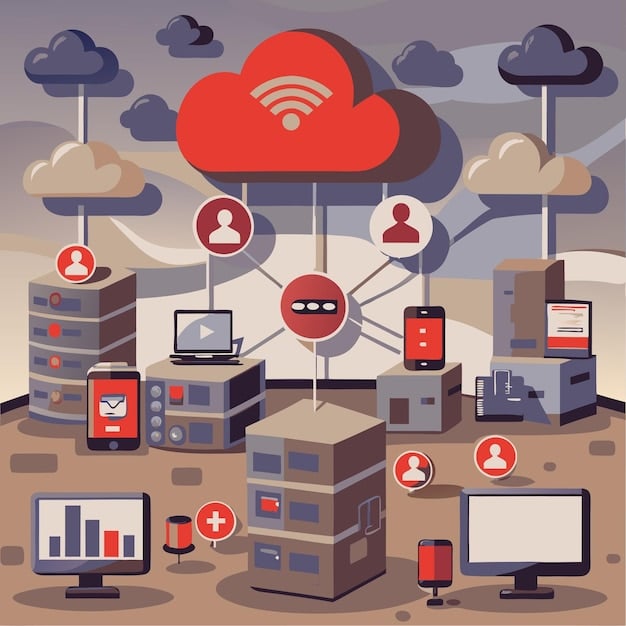Cloud Threat Detection: Best Practices for AWS, Azure, Google Cloud in US

Cloud threat detection involves implementing strategies and tools to identify and mitigate security risks within cloud environments like AWS, Azure, and Google Cloud, ensuring data and applications remain secure in the United States.
In today’s digital landscape, cloud threat detection: best practices for monitoring and securing your data in AWS, Azure, and Google Cloud in US are more critical than ever. With businesses increasingly relying on cloud services, understanding how to protect data and applications from evolving threats is paramount.
Understanding Cloud Threat Detection in the US
Cloud threat detection involves identifying and responding to potential security threats in cloud environments. This is crucial for maintaining data integrity and ensuring business continuity, especially within the stringent regulatory landscape of the United States.
Why is Cloud Threat Detection Important?
Effective cloud threat detection helps organizations proactively address vulnerabilities and prevent breaches. It ensures compliance with industry regulations and protects sensitive data from unauthorized access.
The Unique Challenges of Cloud Security
Cloud environments present unique security challenges, including distributed infrastructure, shared responsibility models, and evolving threat landscapes. Traditional security measures may not be sufficient, requiring specialized solutions.
- Real-time monitoring is essential for identifying anomalies and suspicious activities.
- Automated threat detection and response can help mitigate risks quickly and efficiently.
- Continuous security assessments ensure ongoing protection against emerging threats.
In summary, understanding the importance and challenges of cloud threat detection is the first step toward building a robust security posture within AWS, Azure, and Google Cloud in the US.

Best Practices for AWS Cloud Threat Detection
Amazon Web Services (AWS) offers a range of services and tools for effective cloud threat detection. Implementing these best practices can help organizations enhance their security posture and protect against potential threats.
Leveraging AWS Security Tools
AWS provides services such as CloudTrail, GuardDuty, and Security Hub, which are crucial for monitoring, detecting, and responding to security threats within the AWS environment.
Implementing Identity and Access Management (IAM)
IAM allows you to control access to AWS resources, ensuring that only authorized users have the necessary permissions, reducing the risk of unauthorized access and potential data breaches.
- Enable multi-factor authentication (MFA) for all IAM users.
- Use IAM roles for applications to avoid embedding credentials in code.
- Regularly review and update IAM policies to adhere to the principle of least privilege.
By properly leveraging AWS security tools and IAM, organizations can build a strong foundation for cloud threat detection and response within their AWS environment.
Best Practices for Azure Cloud Threat Detection
Microsoft Azure provides a comprehensive suite of security services for cloud threat detection. Adhering to these best practices ensures a secure and compliant cloud environment.
Utilizing Azure Security Center and Azure Sentinel
Azure Security Center provides unified security management and advanced threat protection, while Azure Sentinel offers intelligent security analytics for detecting and responding to threats across the enterprise.
Implementing Network Security Groups (NSGs)
NSGs allow you to filter network traffic to and from Azure resources, providing an additional layer of security and preventing unauthorized access.
- Create NSG rules that allow only necessary traffic.
- Regularly review and update NSG rules to address evolving threats.
- Implement NSGs at both the subnet and network interface levels.
Effectively using Azure Security Center, Azure Sentinel, and NSGs can greatly enhance cloud threat detection and response capabilities within the Azure environment.

Best Practices for Google Cloud Threat Detection
Google Cloud Platform (GCP) offers a robust set of tools for cloud threat detection. By implementing these best practices, organizations can maintain a secure and compliant cloud environment.
Leveraging Google Cloud Security Command Center and Chronicle
Google Cloud Security Command Center provides a central view of security and data risk in GCP, while Chronicle offers security analytics for detecting and responding to threats.
Implementing Virtual Private Cloud (VPC) Firewall Rules
VPC firewall rules allow you to control network traffic within your VPC, preventing unauthorized access and mitigating potential threats.
- Create firewall rules that allow only necessary traffic.
- Regularly review and update firewall rules to address evolving threats.
- Use network tags to apply firewall rules to specific instances.
By properly utilizing Google Cloud Security Command Center, Chronicle, and VPC firewall rules, organizations can significantly improve their cloud threat detection and response capabilities within the GCP environment.
Monitoring and Logging for Enhanced Cloud Security
Effective monitoring and logging are essential for cloud threat detection. These practices provide visibility into cloud environments, enabling organizations to identify and respond to security incidents promptly.
The Importance of Log Aggregation
Log aggregation involves collecting logs from various sources into a central location for analysis. This provides a comprehensive view of cloud activities and helps identify potential threats.
Implementing Real-Time Monitoring
Real-time monitoring allows organizations to detect and respond to security incidents as they occur, minimizing potential damage and downtime.
- Use monitoring tools to track key security metrics.
- Set up alerts for suspicious activities and anomalies.
- Regularly review monitoring data to identify trends and patterns.
Implementing robust monitoring and logging practices ensures that organizations can quickly detect and respond to security threats, enhancing their overall cloud security posture.
Automation and Orchestration in Cloud Threat Detection
Automation and orchestration play a crucial role in modern cloud threat detection. These capabilities enable organizations to respond quickly and efficiently to security incidents, reducing the impact of potential breaches.
Automated Incident Response
Automated incident response involves using predefined workflows to respond to security incidents. This reduces human error and ensures consistent and timely responses.
Orchestrating Security Tools
Orchestrating security tools involves integrating various security tools to work together seamlessly, improving threat detection and response capabilities.
- Use security automation platforms to orchestrate incident response workflows.
- Integrate security tools with SIEM (Security Information and Event Management) systems.
- Regularly test and update automation and orchestration workflows.
By leveraging automation and orchestration, organizations can enhance their cloud threat detection capabilities and respond more effectively to security incidents in AWS, Azure, and Google Cloud in the US.
Compliance and Regulatory Considerations in the US
Compliance with industry regulations and standards is a critical aspect of cloud threat detection in the US. Organizations must adhere to relevant regulations to protect sensitive data and avoid potential penalties.
Key Regulatory Requirements
Understanding and complying with regulations such as HIPAA, PCI DSS, and GDPR (if applicable) is essential for maintaining a secure and compliant cloud environment in the US.
Implementing Security Controls
Implementing security controls that align with regulatory requirements helps organizations protect sensitive data and demonstrate compliance.
- Conduct regular security assessments to identify vulnerabilities and compliance gaps.
- Implement encryption to protect data at rest and in transit.
- Ensure proper data handling and storage practices.
Adhering to compliance and regulatory considerations is crucial for maintaining a secure and trustworthy cloud environment in the US, ensuring the protection of sensitive data and avoiding potential legal and financial repercussions.
| Key Point | Brief Description |
|---|---|
| 🛡️ AWS Security | Leverage CloudTrail, GuardDuty, and Security Hub for monitoring and protection. |
| ☁️ Azure Security Center | Utilize Azure Security Center and Sentinel for unified security management. |
| 🔒 Google Cloud SCC | Employ Google Cloud Security Command Center and Chronicle for threat detection. |
| 📊 Monitoring & Logging | Implement real-time monitoring and log aggregation for comprehensive visibility. |
FAQ
Cloud threat detection involves identifying and responding to potential security threats in cloud environments like AWS, Azure, and Google Cloud.
It is crucial for maintaining data integrity, ensuring business continuity, and complying with stringent US regulations such as HIPAA and PCI DSS.
AWS provides services like CloudTrail, GuardDuty, and Security Hub for monitoring, detecting, and responding to threats within the AWS environment.
Azure Security Center offers unified security management, while Azure Sentinel provides intelligent security analytics for detecting and responding to threats across the enterprise.
It provides a central view of security and data risk in GCP, while Chronicle offers security analytics for detecting and responding to threats.
Conclusion
Implementing robust cloud threat detection strategies is essential for protecting data and applications in AWS, Azure, and Google Cloud within the US. By following best practices for monitoring, logging, automation, and compliance, organizations can effectively mitigate risks and maintain a secure cloud environment.





